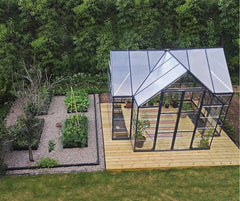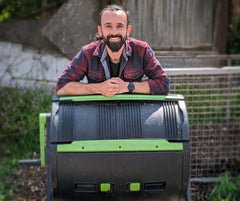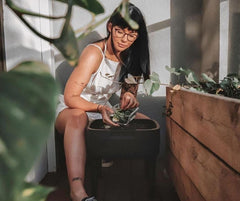
Self-Watering Pots: Perfect for Busy Gardeners
Advantages of self-watering pots and how they make plant care easier
Plant parenting doesn’t have to mean being chained to your watering can. At Maze, we know that life gets busy, but that shouldn’t mean you have to settle for thirsty, wilting plants.
Enter Lechuza self-watering pots, the secret weapon for gardeners who want beautiful, healthy plants without the daily fuss.
Whether you’re caring for a balcony jungle, a kitchen windowsill of herbs, or a whole indoor oasis, self-watering planters make plant care not just easier, but smarter.
Let’s dig into the real benefits, answer your burning questions, and show you how our Lechuza self-watering pots can make anyone a plant pro, even on the busiest days.
What Are Self-Watering Pots and How Do They Work?
Self-watering pots are designed to deliver water to your plants exactly when they need it - no more, no less. Our Lechuza range uses a clever sub-irrigation system: there’s a built-in reservoir at the bottom of the pot.
As the PON Plant Substrate / soil dries out, water is drawn up from below, keeping your plants perfectly hydrated.
You simply fill the reservoir, and the planter does the rest. Most of our self-watering systems also feature a water level indicator, so you always know when it’s time for a top-up. It’s low-fuss, low-stress, and incredibly effective.
Why is this better than a standard pot?
Traditional pots drain water straight out the bottom, so plants can go from soggy to parched in days. Self-watering pots keep moisture consistent, which is essential for healthy roots and lush growth. It’s a game-changer for both indoor and outdoor gardeners.

Advantages of Self-Watering Pots for Busy Gardeners
1. Less Frequent Watering
Forget the daily watering routine. With a self-watering system, you might only need to top up every week or two - even less for larger pots or outdoor use.
2. Consistent Moisture for Happier Plants
Plants love routine as much as we do. Self-watering pots deliver steady moisture, which reduces stress and encourages stronger, healthier growth. No more drooping leaves after a long weekend away.
3. Built-In Protection Against Overwatering
It’s all too easy to kill plants with kindness (and too much water). Lechuza’s system prevents soggy roots and reduces the risk of rot by keeping excess water separate from the soil until your plant actually needs it.
4. Time-Saving, Stress-Free Plant Care
Self-watering pots are perfect for anyone with a hectic schedule or those prone to forgetting their watering days. They’re also ideal for offices, rental properties, and anyone who travels often.
5. Suitable for Indoors and Outdoors
Our self-watering planters look stunning on a patio, balcony, kitchen counter, or windowsill. They help you grow everything from ferns to tomatoes with less effort.

Why We Love Lechuza Self-Watering Pots
Maze is proud to offer a selected range of Lechuza self-watering pots widely regarded as some of the best pots for busy gardeners.
Here’s what sets Lechuza apart:
-
Premium German engineering for durability and style
-
Water level indicators to take out the guesswork
-
Variety of sizes, shapes, and colours for every space
-
Easy to assemble and clean, with no special tools required
-
Ideal for both beginners and plant lovers with years of experience
Our customers rave about how much healthier and fuller their plants are after switching to self-watering planters. Even the forgetful among us can enjoy a thriving indoor jungle.
Which Plants Thrive in Self-Watering Planters?
Most popular houseplants and herbs do exceptionally well in self-watering pots, especially those that prefer consistent moisture. Some Maze favourites include:
-
Peace lilies
-
Pothos
-
Ferns
-
Spider plants
-
Basil, mint, parsley, and other herbs
-
Indoor palms
-
Succulents (just go easy on the water and monitor the reservoir)

Frequently Asked Questions
1. How do self-watering pots work?
They use a reservoir and a wicking system, so water is delivered to your plant’s roots as needed. Just fill the bottom chamber, and the plant will draw up water automatically.
2. What plants are best for self-watering planters?
Most leafy greens, herbs, flowering indoor plants, and tropicals do brilliantly. Avoid plants that prefer dry conditions (like some cacti) unless you allow the soil to dry out fully between waterings.
3. How often should I refill a self-watering pot?
It depends on the plant and environment, but most Maze self-watering pots only need topping up every one to two weeks. The built-in indicator will let you know.
Best Practices for Using Self-Watering Pots
-
Always use a quality potting mix or PON Substrate: Avoid garden soil, which can clog the system.
-
Clean the reservoir every few months: This keeps things fresh and prevents build-up.
-
Don’t overfill: Only fill to the indicator line. Excess water will drain away.
-
Check the indicator regularly: Get to know your plant’s habits for best results.
Discover the Full Range
Ready to ditch the daily watering can?
Explore our complete range of Lechuza self-watering pots and take the stress out of plant care, no matter how busy life gets.




